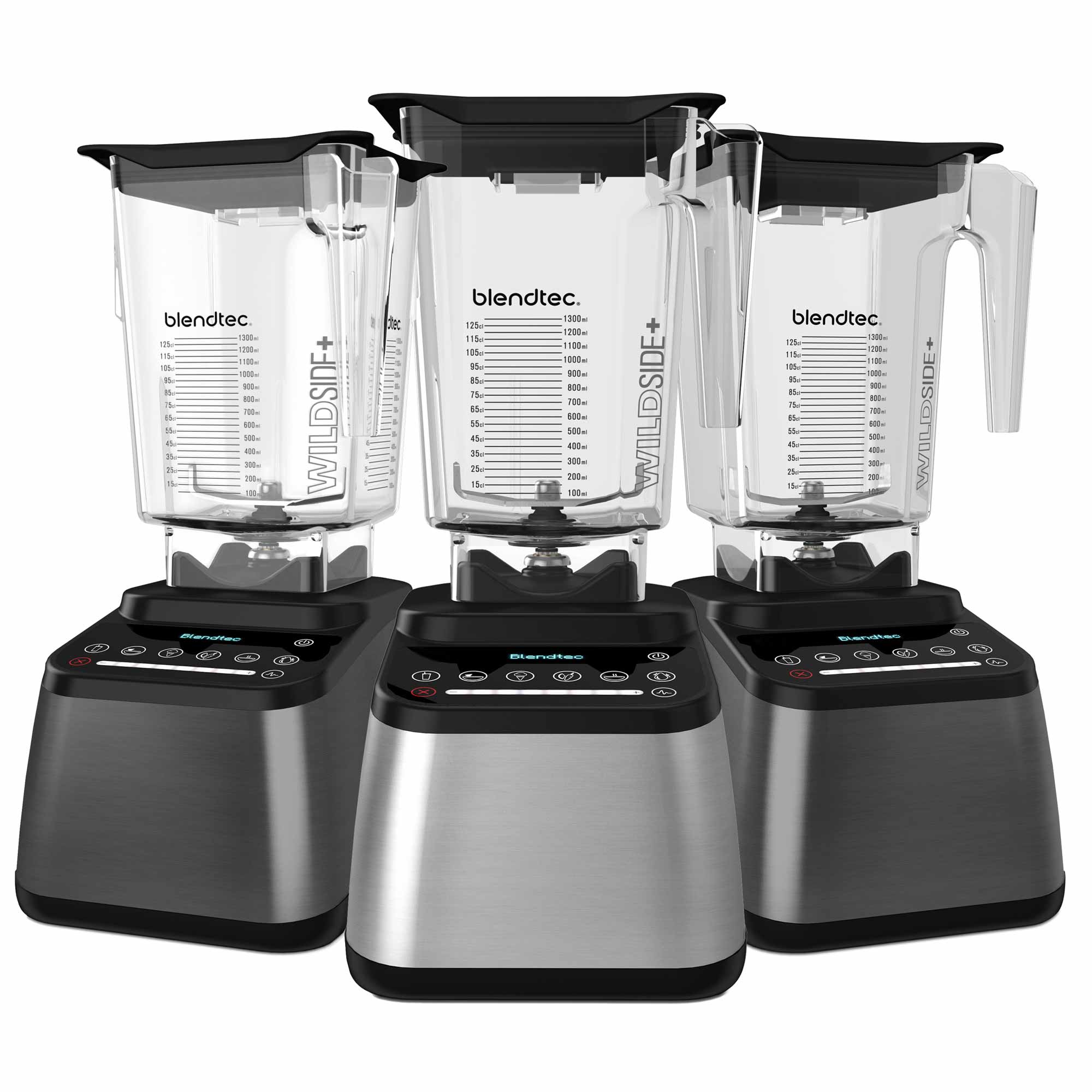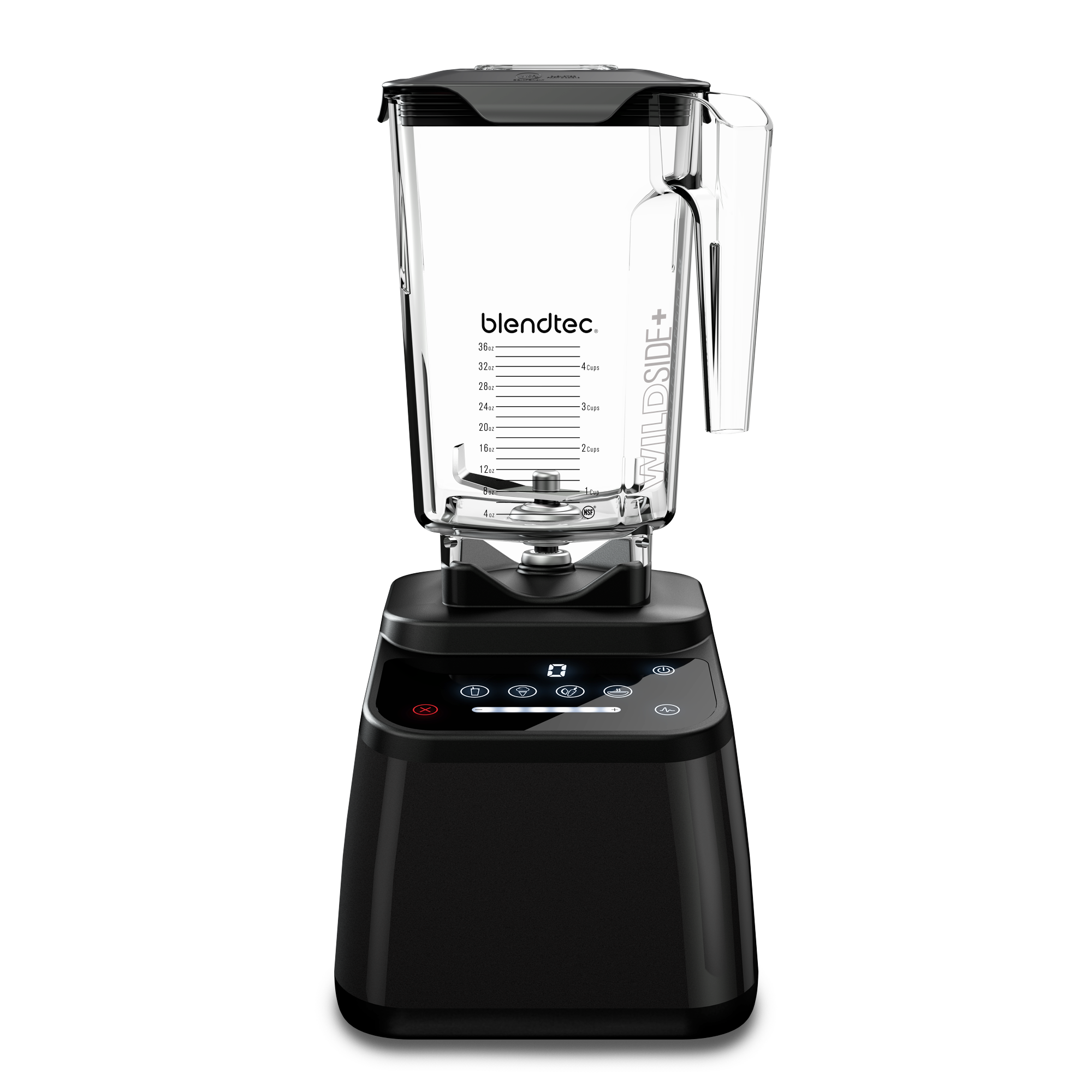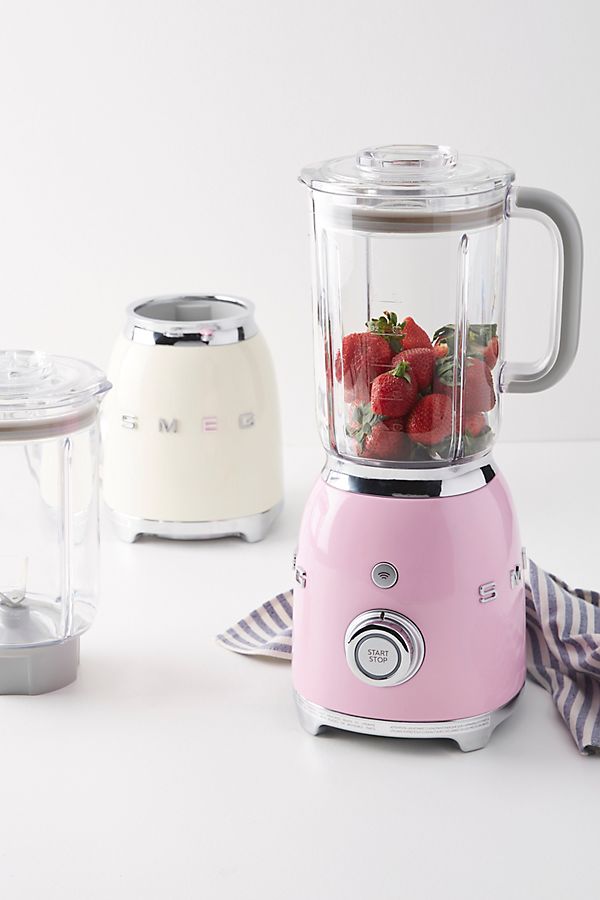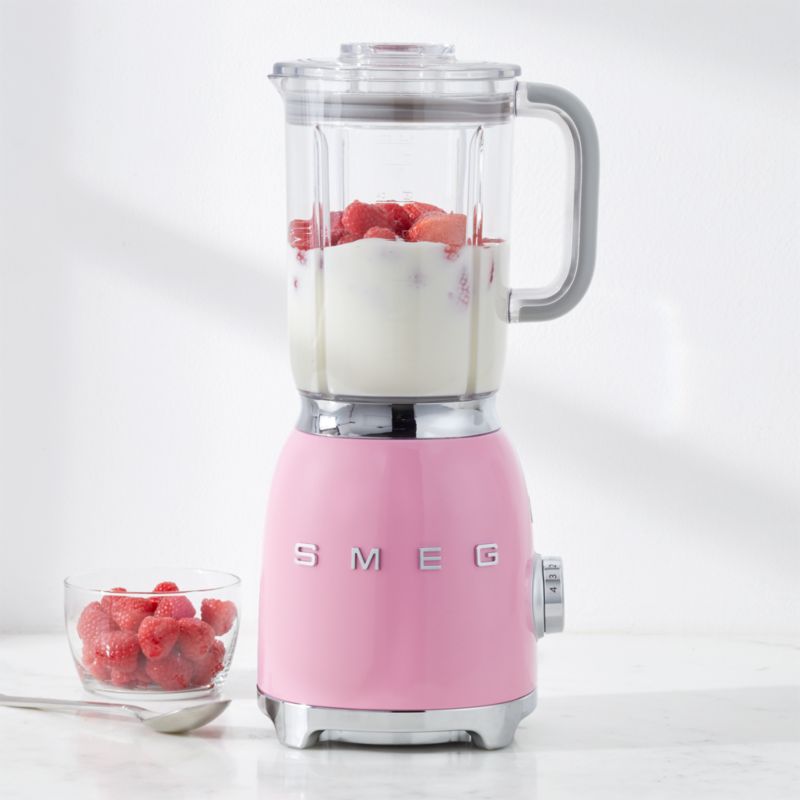Introduced in late 2004, the Total Blender continues to be Blendtec's (a division of K-TEC, Inc.) most user-friendly offering in the high-performance blender market. Contrary to the claims of many online reviews, the Total Blender was not simply a revision of the company's wildly popular Champ HP3 model found in numerous smoothie and coffee shops across the country in the early 2000s. There was, in fact, a redesign of the Champ HP3. It is now known as the HP3A and is a fine blender in its own right. The motivation behind the Total Blender, however, was to use the same mechanical components found in their commercial machines and combine them with a much simpler interface, resulting in the company's first model made specifically for home use. The following review combines information gathered directly from the company with my experience of over 30,000 cycles of use as a representative of Blendtec at live demonstrations of the Total Blender across the country.
Package and Specifications
The Total Blender is made and assembled in Blendtec's Orem, Utah, manufacturing facility. Currently, the package includes a motor base, jar, two-part lid, user manual, instructional DVD, and recipe book. The purchaser has his or her choice of black, white, or red motor base finishes. A coffee colored base was discontinued in early 2011.
The base of the machine comprises the majority of its heft (7 lbs. with an empty jar), and contains a direct-drive, 13 amp, 1560 watt motor, referred to in industry circles as 3 horsepower (3 HP). Blendtec used to refer to the motor as 3-peak horsepower, but now generally refrains from use of the term horsepower altogether in its literature, packaging, and online descriptions, most likely due to the general public's lack of understanding of how true HP is calculated, and, hence, potentially misunderstood. The Total Blender's direct-drive motor insures no loss of power incurred via friction generated from pulleys, belts, or clutches. Instead, the motor itself spins the jar's blade at high-torque speeds of nearly 29,000 revolutions per minute (RPM).
Motor base dimensions are 7" wide by 8" deep, and the entire unit, with the jar in place - lid on - stands exactly 15" tall. The height of the Total Blender is an important dimension for consumers wishing to keep the unit on a countertop when not in use, as the standard installation height of upper-kitchen cabinets is between 17" and 18" above countertops. A three-foot power cord with a standard 120 volt, 3-prong plug extends from the rear of the machine. Also on the back of the base is the main power On/Off switch. The motor vents from its underside, and the entire base rests on four round, rubber feet, 7/8" in diameter. The colored portion of the motor base cover is made of a durable polycarbonate with no seams or openings for liquid penetration.
Traditional knobs and levers used to operate the machine are absent on the Total Blender. Instead, the interface consists of nine small buttons, each labeled with its corresponding function. Six are pre-programed "blend cycle" buttons. From left to right, they are labeled Ice Cream/Frozen Yogurt, Ice Crush/Milkshake, Soups/Syrups/Fondues, Sauces/Dips/Dressings/Batters, Whole Juice, and Smoothies. Just above the row of blend cycles, one button manually speeds the machine up, one manually slows it down, and, finally, one is for pulsing. When lit, a small blue light next to the Pulse button indicates the main power is on. Just below the interface panel is a blue LCD screen which displays information such as the particular blend cycle in use, time remaining in cycle, overload indication (if implemented), and total number of cycles run.
The design of the Total Blender's jar has been patented by Blendtec. Because it is square in shape, contents are able to be poured from any of three slightly tapered corners, all of which resemble spouts. The container itself has a capacity of two quarts (64 ounces) and is made of a high-strength Bisphenol A (BPA)-free copolyester. Measurements in ounces and cups are marked on two sides of the jar incrementally up to one quart (32 ounces/4 cups). It is also marked with the registered NSF International stamp, meaning it meets the foundation's (formerly known as the National Sanitation Foundation) requirements for equipment and material intended for commercial foodservice, a general benchmark for public health standards.
The blade assembly features a single 3" stainless steel blade that turns in one direction, clockwise. This assembly is sonically fused onto the jar and does not detach. From the underside of the jar, the slotted metal end of the blade shaft fits perfectly into the correspondingly-grooved drive socket of a titanium coupling. Along with the blade shaft/drive socket connection, a 1 ¼"-deep continuous lip extends from the bottom of the jar, insuring it rests securely on the upper extension of the motor base while the blender is in use.
The jar's lid has undergone several revisions since the model's inception. Now a two-piece design, the latest form consists of a rubber primary cover, molded to form a lip that fits snugly around the top edge of all four sides of the container. On each corner of this lid are subtle flaps designed for easy removal from the jar using just a thumb and forefinger. A 2" by 2" opening in the center of the primary cover receives the second piece of the two-piece assembly, a removable, hard-plastic cap which, when fitted into the opening, creates a four-way vent from which pressure escapes during the blending of hot recipes. The removal of this cap from the primary cover also allows for the addition of ingredients into the jar while the blender runs without having to remove the entire lid.
A 245-page recipe book called Lifestyles contains instructions on blender use, health and nutrition information, a Glycemic Index chart, dry and liquid measurement equivalents tables, an ingredient substitution chart, and over 300 recipes. Paired with each recipe is a nutritional content table similar to those found on food packaging, as well as its content yield.
Completing the Total Blender package is a 19-page owner's manual and user guide providing safety information, a more detailed overview of the blender's six blend cycles, troubleshooting tips, and details on the machine's standard warranty, which is three years from the date of purchase. Purchases made at leading membership clubs - Costco and Sam's Club, for example - include a warranty extension good for an additional four years on the motor base. The titanium coupling (the drive socket for the blade assembly) and the stainless steel blade, however, are covered beyond the standard warranty. Though this is not specifically mentioned in the warranty's wording, both of these parts are guaranteed against defect for the life of the machine.
Operation
Using the Total Blender can be as simple as loading the jar and pushing a button. For the majority of recipes, though, excellent results using the pre-programed blend cycles do require a bit of forethought from the user. Key to desired consistency with any blender is a proper ratio of liquid to dry ingredients. When making ice cream, for example, too much liquid in relation to ice or frozen fruit results in a less-than-solid (runny) consistency. Likewise, too much ice in relation to liquid might result in a not-so-smooth (crunchy) dessert. In every Lifestyles recipe, both the volume and ratios of all ingredients have been pre-calculated to - when paired with their corresponding blend cycles - yield consistently excellent results. In other words, if a user follows the recipe, and presses the right button, he or she will get the desired result.
Once a blend cycle is selected, users will detect multiple blade speed changes throughout its duration. No blend cycle runs at a single speed. Instead, as few as three to as many as eight speed changes may occur over the course of a given cycle. Blendtec has determined specific speeds and durations for corresponding ingredients in each of its recipes. Blend cycle duration ranges from 25 seconds on the Smoothie cycle to 90 seconds for Soups/Syrups/Fondues. Once a cycle is selected, a timer on the LCD screen will count down, informing the user of the number of seconds before its completion. Once running, blend cycles are not intended to be stopped until the cycle ends. However, while the machine is running, pressing any blend cycle button will halt it. This is why no "Off" button is found on the interface panel. They are all "Off" buttons.
Along with user attention to ingredient quantity and ratios, equal importance should also be placed on the order in which they are loaded into the jar. When following any recipe in the Lifestyles book, the first ingredient listed goes into the jar first. As the user works his way down the recipe, the ingredients should be loaded from the bottom of the jar upward. If the correct ratio of the right ingredients is loaded into the jar in the right order, and the correct blend cycle is selected, the machine produces the desired result. User guesswork as to proper blender speed and duration is completely eliminated.
Of course, users won't want to be limited solely to the 300+ recipes in the book. For this reason, manual controls are also included on the interface panel. Marked with arrows indicating "Speed Up" and "Speed Down," these buttons access each of the blender's ten speeds incrementally, with Speed 10 representing the highest at over 28,000 RPMs. The user moves from one speed to the next by pressing the button once for each successive speed.
The machine will also climb and descend automatically from one speed to the next if the button is held depressed. Once a manual cycle starts, the Total Blender will run for a total of 50 seconds at which point it will shut itself off. Instead of counting down from 50, however, the timer will start at zero and count upward. Specific durations for specific recipes designed by the user can be monitored with the timer counting in this manner. For example, if the user creates his own smoothie recipe and determines, based on his specific ingredients, he needs to run the machine at Speed 6 for exactly 35 seconds, this is possible with the manual controls. In short, the manual buttons on the panel interface allow the user to operate the machine as he or she would any other blender.
This is not to say that blend cycles cannot or should not be used when making a recipe not included in the Lifestyles book. It's quite possible to achieve perfect results using a blend cycle in conjunction with a recipe found elsewhere or created by the user, himself. Any recipe that mimics one from the Lifestyles book in both quantity and ratio is likely to result in a similar consistency via the corresponding blend cycle. Adjustments can always be made to any recipe, however, whether from the book or not, using the manual controls. Experience is the best teacher with the Total Blender. The more it is used, the more familiar with the results produced the user becomes with both each particular blend cycle as well as the manually-operated buttons.
The Pulse button operates just as one would imagine. It will run at a medium-high speed for only as long as it is held depressed. Short bursts are great for chopping ingredients instead of pureeing. Longer durations can be used for anything from cleaning the jar with soap and water to incorporating a forgotten or additional ingredient to making a smoothie outright.
Performance
In terms of sheer power, I've yet to see or use a blender in this price range that matches that of the Total Blender. Any conceivable ingredient a user might want to blend will most likely be no problem for this machine. In over 30,000 personal and demonstration cycles with this particular model (and many of my customers could verify that I do not "baby" these machines), I've never placed anything into the jar that has caused it to fail to run and run properly.
However, were a user to do just that, inside the housing is a sensor which will temporarily trip power to the motor. Instead of the motor running continuously and eventually burning itself out trying to blend difficult ingredients - not uncommon with regular blenders - it will instead shut itself down and present an "Overload" reading on the LCD screen. If this occurs the user simply removes or adjusts the ingredient(s) in question and presses any blend cycle button, after which the machine is immediately ready to resume work. I demonstrate this feature occasionally by placing the handle of a hammer into the jar against the blade while the machine is in an off position, and then holding it firmly against the bottom of the jar while simultaneously starting a cycle. Because of the sheer power of the Total Blender it is a battle keeping the handle in place once a button is pressed, but after two or three seconds the sensor halts the motor every time. Likewise, there is an "Overtemp" reading that will appear if the motor has overheated during use. To date, I've yet to actually see this reading via normal use, nor have I been able to create a demonstration which implements it.
This extreme power, along with the design of both the jar and blade, is the key to consistently successful blended results with the Total Blender. Instead of swirling around the perimeter of a round jar, as ingredient contents tend to do at high speeds with most blenders, ingredients in this jar will deaden, in effect, as they hit the corners created by its square design. In theory, contents are then redirected to the jar's center, where the patented blade design and motor power combine to actually draw ingredients down into the cutting path of the blade to be fully incorporated. This vortex effect is repeated throughout the duration of the cycle, meaning ingredients are constantly and consistently reincorporated, start to finish. On the Ice Cream/Frozen Yogurt cycle the user can most clearly see this effect at work. Ingredients from the top are drawn down to the blade, incorporated, then pushed up the side of the jar, back to the center, and drawn down again.
Ice Cream/Frozen Yogurt and Soups/Syrups/Fondues are the blend cycles that best demonstrate the Total Blender's extreme diversity. Determining whether a recipe becomes hot to the point of boiling (if desired) or frozen like soft-serve are two main factors: the right ingredients, of course, and the proper amount of friction generated against them by the spinning blade. There is no heating element in the machine. Instead, the amount of friction introduced to the user's ingredient contents on every cycle will determine to what extent the recipe heats. Extreme amounts are created at 28,000 RPMs (the 90-second Soups/Syrups/Fondues cycle), enough to create a piping-hot soup.
How hot, exactly, is determined simply by how long the blade spins. This particular cycle is 90 seconds. Most soup recipes calling for hot water as an ingredient are sufficiently warmed after one cycle. However, to increase the desired temperature of the final product, the user simply has to restart the cycle. Extremely hot temperatures can be achieved in 4 ½ to 5 minutes (3 or 4 cycles). Partial cycles can also be run by pressing any blend cycle button mid-cycle, thus allowing for temperature-specific heating (requires the use of a thermometer). Keep in mind, regarding soups, hotter temperatures result in correspondingly decreased ingredient nutritional yield. This is something of which to always be mindful.
On the opposite end of the temperature scale, friction is also used to create ice cream in the Total Blender. Much slower blade speeds on this cycle create much less friction, obviously. But with the right ingredients and the right amount of friction, in combination with the motor's high torque, the Ice Cream/Frozen Yogurt cycle turns ice and/or frozen fruit and other ingredients into perfect soft-serve ice cream consistencies. Ranging somewhere between the extreme blade speed differences of the soup and ice cream cycles, those for whole fruit juices, smoothies, sauces, dressings, and milkshakes are all created using separate cycles that implement the exact same design principals.
Extreme torque and blade speeds generated by the Total Blender can also rupture individual cell walls of fruits and vegetables, unlocking valuable nutrients that would otherwise digest unutilized when simply eaten or blended less effectively. The Whole Juice cycle is designed specifically to promote a maximum nutritional yield from whole fruits and vegetables.
The patented design of the Total Blender's blade also enables the same container and blade assembly that blends "wet" ingredients to serve as a mill for grinding whole grains, seeds, beans, and nuts into flours of any almost any consistency. At lower speeds, instead of flours, the Total Blender makes excellent nut butters out of peanuts, almonds, walnuts, cashews, and pecans. Uses of these kinds do not affect performance of the blade as it is manufactured with a rather blunt edge as opposed to the sharp edge found on most blender blades. The Total Blender utilizes its unique blade and jar design along with the muscle of the motor to pulverize, rather than slice, ingredients loaded into it.
The Total Blender also makes excellent bread doughs, cake batters, pie fillings, dips, salsas, fondues, syrups, frozen alcoholic beverages, baby food, etc. Recipes for all of the above are included in the Lifestyles book.
Performance Issues
Assuming no perfect blending machine has ever been created, a comprehensive review of The Total Blender must also include its drawbacks. While this blender has few, in order of importance to this user, they are listed as follows: Noise. It is loud. I have not taken decibel-level readings on it, and acoustics vary from one kitchen to the next, but I feel confident claiming it is as loud or louder than any regular household blender on the market today. Keep in mind most cycle durations are short, and noise will certainly be dictated by both ingredient content and speeds. However, aftermarket sound-enclosures for the Total Blender are available through various sources on the internet. Blendtec, though, does not make one for this model.
As mentioned previously, it is suggested recipe ingredients be loaded into the jar in a particular order. No tool for assisting ingredients into the cutting path of the blade is included with this model, and for most recipes, regardless of the order in which ingredients are loaded, none is required. There will be occasions, however, where solid or frozen ingredients loaded lower into the jar delay the incorporation of the entire set of ingredients to the point where additional blending times might be required after a pre-set cycle has concluded.
Cavitation is a common occurrence amongst all blenders whereby an air pocket develops around the cutting path of the blade, preventing ingredients from reaching it. Extremely cold ingredient temperatures are the main culprits in this instance, and the Total Blender is not invulnerable to this condition. Adding liquid to a recipe, eliminating the air pocket manually with a spatula, or simply running the machine manually at high speeds quickly remedies cavitation issues.
The length of uninterrupted manual use (as opposed to blend cycles) of the machine is capped at 50 seconds. In other words, manual use duration via the Speed Up and/or Speed Down controls is also technically on a cycle. For manual blending requiring times in excess of 50 seconds, the user must re-start the blending process after 50 seconds.
Finally, use of the jar as a mill will result in the bottom 1/3 to 1/2 of the jar taking on a cloudy appearance - the result of minute indentations created by grains as they are being thrown against the jar's sides at extreme speeds during grinding. This, too, is common with all polycarbonate and copolyester jars which are required for high-performance blending (glass jars cannot withstand the torques generated by these motors). Likewise, milling of oily beans (coffee, for example) may stain the jar. No performance issues result from these effects, however. They are purely aesthetic.
Summary
The Blendtec Total Blender is perfect for anyone wanting an extremely powerful, versatile blender that yields health benefits not available from regular blenders. For the money, one cannot find a stronger, more durable machine. Its American-made craftsmanship is superb. One could reasonably expect it to be the last blender he might ever purchase. This machine is "smart" enough to do the majority of the "work" for the user, yet also allows him to assume complete control of the blending process. The same motor and technology found in this machine can be found in those of coffee houses, smoothie shops and restaurants all over the world. Those places, too, have their options when it comes to blenders, and there is a reason they ultimately choose Blendtecs. It's because they are worth every penny.














